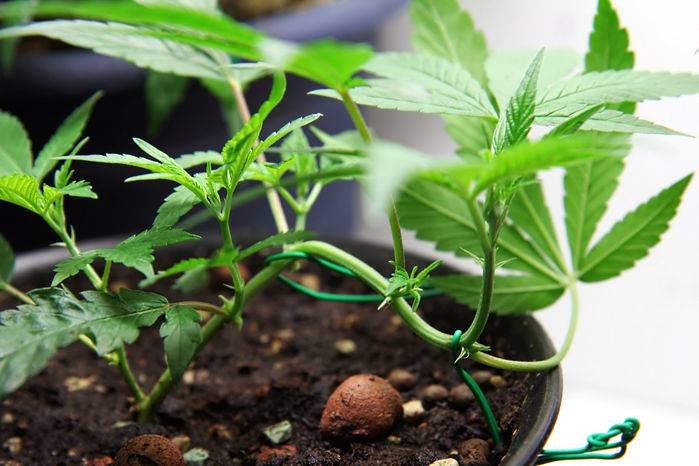-
ICMag with help from Phlizon, Landrace Warden and The Vault is running a NEW contest for Christmas! You can check it here. Prizes are: full spectrum led light, seeds & forum premium access. Come join in!
You are using an out of date browser. It may not display this or other websites correctly.
You should upgrade or use an alternative browser.
You should upgrade or use an alternative browser.
A Complete Guide to Topping, Training and Pruning
- Thread starter Kodiak
- Start date
.
Thanks Time2Unite, I am glad that you approve. Training your plants is a great way to control the stretch and increase your yield indoors.
.
don't forget about outdoors....thats where these methods really shine also....u can shape then so they don't look like the typical christmas tree pot plant the feds look for.... u can top and fim for more growing shoots, throw in some supercropping, lst, and pruning all in the same veg cycle...u can do alot to a plant when it vegges 4-5 months before it starts to flower!
K
K-pax
I'm really happy to have found this thread this is just awesome info THANKYOU SO MUCH for putting this together and taking the time to share this knowledge..You are much appreciated..

X
xinsanewickedx
kodiak : thanks for kicking down all this knowledge.this is an awesome thread
k-pax: good find brother!
k-pax: good find brother!
Thanks everyone, sharing is what this forum is all about and I am happy that so many are finding the guide useful. The more good weed we grow the better it gets.
Time2Unite made a good point, all of the techniques mentioned here can be applied to outdoor grows with good results. The tall and typical "christmas tree" plants do draw more attention. You can train your plants outdoors to stay low while increasing your yield. Changing the shape of the plants also make them more stealthy at the same time. Safety first.
Keep it green
Time2Unite made a good point, all of the techniques mentioned here can be applied to outdoor grows with good results. The tall and typical "christmas tree" plants do draw more attention. You can train your plants outdoors to stay low while increasing your yield. Changing the shape of the plants also make them more stealthy at the same time. Safety first.
Keep it green
Excellent information here!! The books we have just aren't descriptive enough for beginners like us-Thanks for your time and effort to help us!!!!
In terms of plant size; how young can I start LST? The main shoot is between 1/8" and 1/4" and about 6-8" tall. Lots of bushy growth already-7 nodes
In terms of plant size; how young can I start LST? The main shoot is between 1/8" and 1/4" and about 6-8" tall. Lots of bushy growth already-7 nodes
Thanks guys, I'm glad that you liked it.
Newb, since your plant already has seven nodes, I would say that it is completely safe to start training it.
Just for general refence; when you top the main stem, that part of the plant will never grow again so you need to make sure that you have enough nodes beneath the cut for the plant to survive and grow new shoots. I usually top my plants when I see new growth at the lower nodes. As soon as the new tops start shooting for the sky, you can start LST'ing the plant. There is no golden rule for this stuff so go by your gut feeling. Usually you will know just by looking at the plant if it's ready or not.
Good luck and keep it green
Newb, since your plant already has seven nodes, I would say that it is completely safe to start training it.
Just for general refence; when you top the main stem, that part of the plant will never grow again so you need to make sure that you have enough nodes beneath the cut for the plant to survive and grow new shoots. I usually top my plants when I see new growth at the lower nodes. As soon as the new tops start shooting for the sky, you can start LST'ing the plant. There is no golden rule for this stuff so go by your gut feeling. Usually you will know just by looking at the plant if it's ready or not.
Good luck and keep it green
StonedOlle
New member
Verry good readning. 

Great work Kodiak K+!!!
thank you for the great infoA complete guide to topping, training and pruning
I got some requests for pointers on how to train your plants for a maximized crop, so I put this guide together. I will cover the basic idea behind topping the plant and how to apply the various techniques in combination for the best results. Keep in mind that this is only one method of growing and that there are many other ways to do it.
Topping
Topping the plant means that you remove the main shoot located on the stem. By doing so you will encourage the plant to grow into a bush with a lot of shoots, instead of one big main shoot that you get on the untopped “christmas tree”.
The reason why the plant behaves this way is because the center of growth control, the auxin transport system, is located in the main shoot apex. Sensory pigments in the leafs inform the plant of various things like how much light a leaf at a certain location gets and so on, which then enables the plant to transport energy and growth hormones to various areas.
The mechanism behind the auxin transport system is quite complex, involving various messenger molecules, growth hormones and specific proteins that trigger everything from vegetative growth to flowering in the plant. Some aspects of this mechanism are still unknown and under scientific research. What is known however is that the centre of control for this mechanism is located in the main shoot apex and that it also relies on information from the sensory pigments located in the leafs.
By removing the main shoot, the communication between the leafs and main shoot ends and the result is that the plant assigns the next shoots in line to the job. This means that the smaller shoots on the node beneath the cut starts growing faster and gain height. These shoots usually grow very slowly when the plant is left untopped. It is probably best to top the plant at night as then most of the hormones have been sent to the roots, which means that there is a smaller chance of the plant being stunted after the main shoot has been removed.
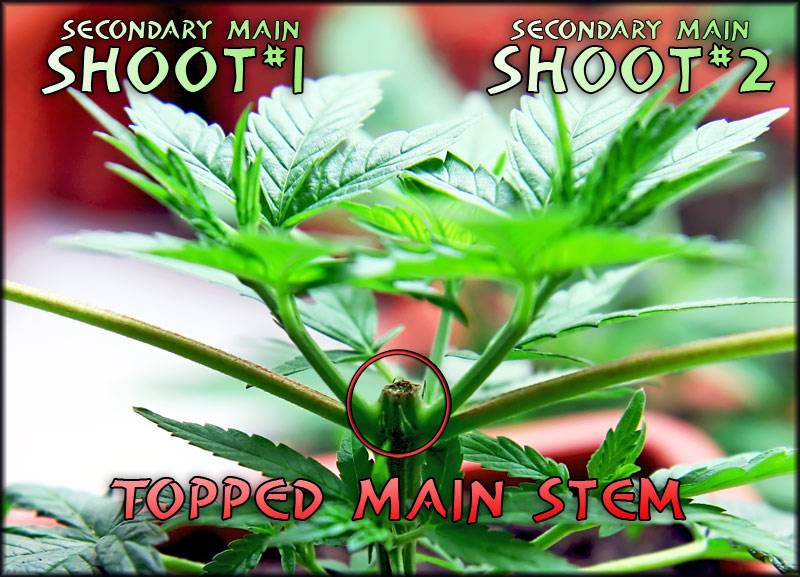
Most of the time this transition is quite fast but some plants that respond poorly to topping might have stunted growth for a while. It is possible to top a plant many times, each time the number of main shoots will double. Give your plants some time to grow before you top them, if they are topped to early they might get stunted for a while. I do top them quite early sometimes as you can probably tell from the pictures that I have included. Go by your feeling, once the plants look strong enough you can start topping and training them.
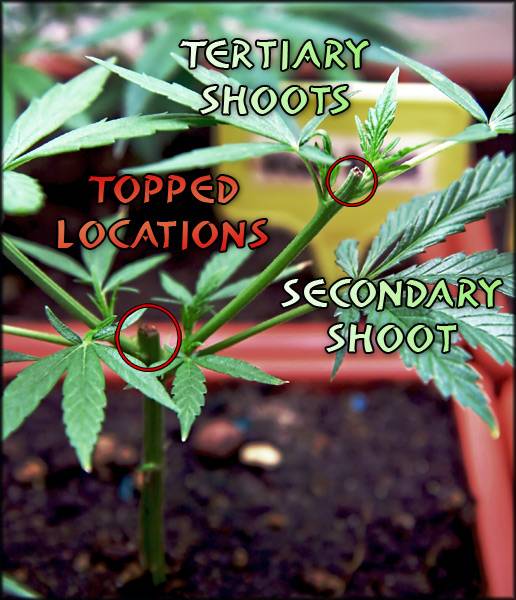
This is a good way of training the plant if one wants to make the most out of the space available. Topping is also a good way of slowing down plants that tend to stretch a lot, as each time the plant is topped it will redirect energy to a greater number of shoots. The new shoots will never grow as large as the untopped main shoot will but they will most likely produce a larger crop.
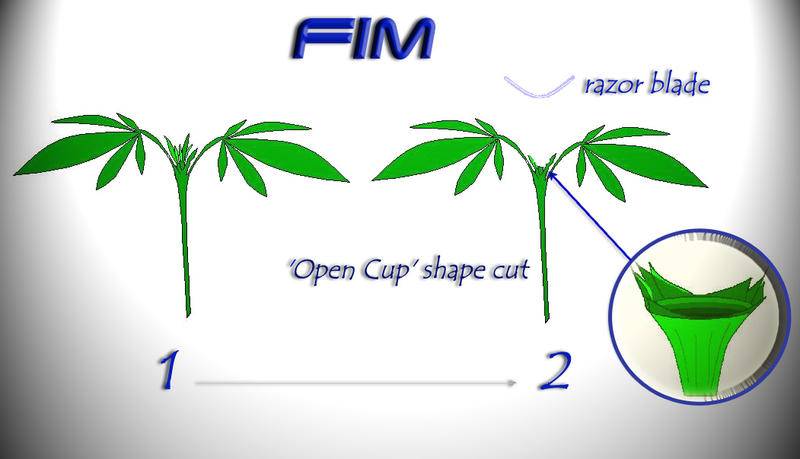
(Credit to the original creator of this picture)
There is also a technique called FIM (Fuck I Missed) topping. By leaving a small portion of the growth on the main shoot intact, the plant will for some reason assume that four shoots, instead of two, are the main shoots and they will grow evenly in height. The success of this method is usually up to the luck of the draw but you should make the cut circular so that the remaining tissue forms a “cup”. The same result can however be achieved by topping the plant twice.
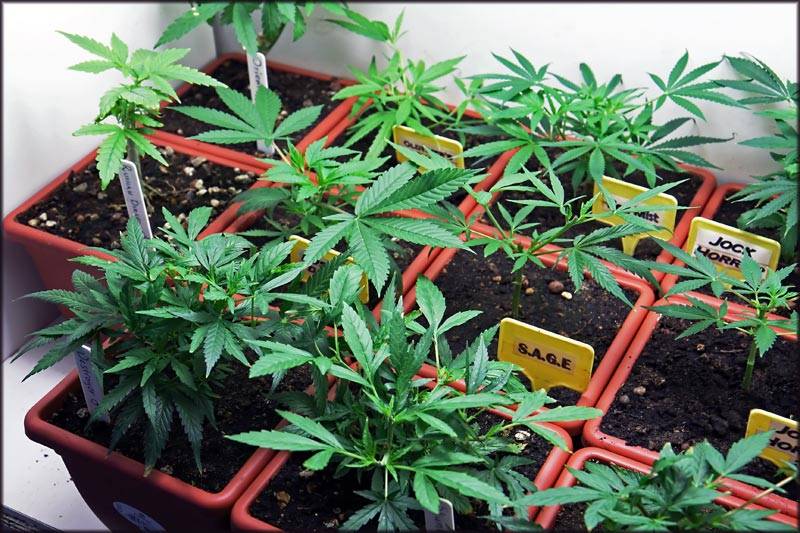
Here are some plants in various stages of training.
Super Cropping
There is also a technique called super cropping, which involves crushing of the soft inner hurd of the stem in order to gain some control over the plant, but mainly to increase health, potency and yield. This soft inner hurd is made up of cellulose and forms a network of vascular tissue that can be divided into two groups, namely the xylem and phloem. These two are responsible for the transport of water and nutrients along the stem.
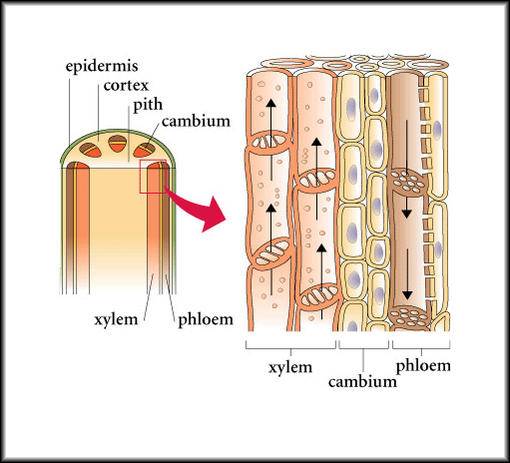
Breaking the plant's inner walls will cause it to rebuild. The plant will rebuild the tissue stronger than before and this is why this technique can increase the harvest. While rebuilding the tissue the plant expands on the network of cellulose, which is why the stem grows thicker than before at the point where it was crushed. Think of it this way; instead of having a two way street for water and nutrient transport, you now have a multi-laned super highway.
If you pinch the main stem it will grow very thick, which will benefit the entire plant. Pinching the side branches will allow you to have more control over how she takes shape. Thanks to the bend on the newly crushed branch you can now redirect it in any way that you see fit. This will also allow more light to reach the lower buds. Since the branch will grow stronger at the breaking point, it will also be able to support more weight. The branches that are closest to the breaking point will also grow stronger in order to compensate for the injury.
Here we can see how the stem has grown stronger where the vascular tissue was damaged and then repaired.
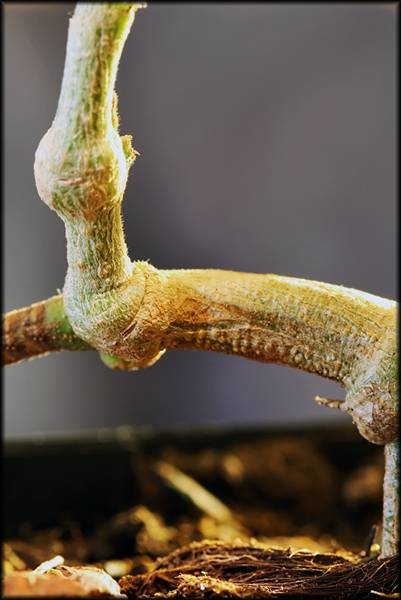
The idea here is to some gain control over the shape of the plant while improving on health and increasing her yield. Pinched plants usually grow into very healthy bushes with thick stems. Super cropping is also a good way of getting several main colas. The pinched branches will eventually grow so thick that the plant will treat them as if they were main colas instead of secondary branches. The added stress that comes with super cropping might also increase potency.
Super cropping should be carried out during the second or third week of vegetative growth. Take a branch between your forefinger and thumb and proceed to pinch and twist at the same time until you feel the insides start to collapse under the pressure of your fingers. Slowly squeeze and bend the stem without snapping it. Just squeeze lightly until you feel the branch give, then let go. The branch might droop for a while but that's ok as it will heal over time.
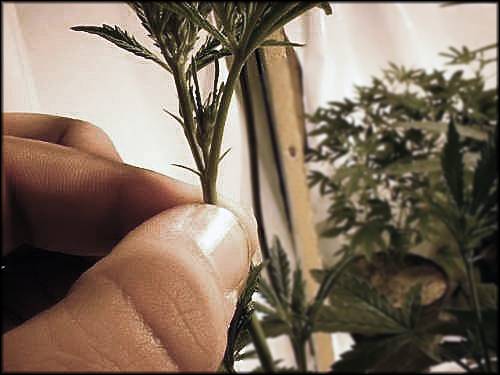
Keep in mind that sometimes you will have to keep the plant in a vegetative state a bit longer than usual as it takes the plant some time to repair the broken tissue and redirect energy. It is probably best to choose either topping/LST training or super cropping, as both techniques have the same purpose and applying all of them at the same time might put the plant under too much stress. Pruning super cropped plants might however become necessary at some point or the other in order to ensure that the plant is functioning at it's full potential
If this technique is applied correctly and with patience, the outcome will most likely be a stronger, bushier plant and a greater harvest.
Low Stress Training
Topping the plant or Super Cropping can be considered High Stress Training (HST), which might upset the plant to some degree. There is however another option called LST or Low Stress Training.
Topping and LST training work quite well together but it's not necessary to top the plant in order to start the LST training. Some people prefer to leave the plant untopped and tie down the main shoot at ground level instead. This will have the same effect as topping it because once again, the auxin transport system located in the main shoot will dictate how the plant grows. When the main shoot is tied down, all shoots above it will grow more rapidly as the plant now assumes that these are the main shoots.
These diagrams, originally posted by big_buddha, give a good picture of what I am talking about. These are excellent diagrams so many thanks to the creator.
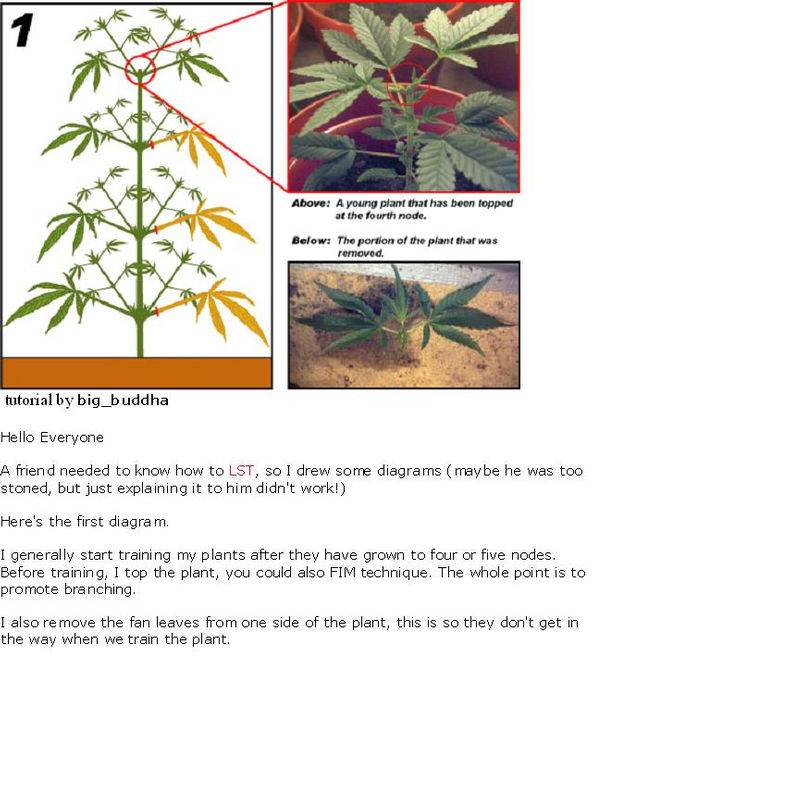
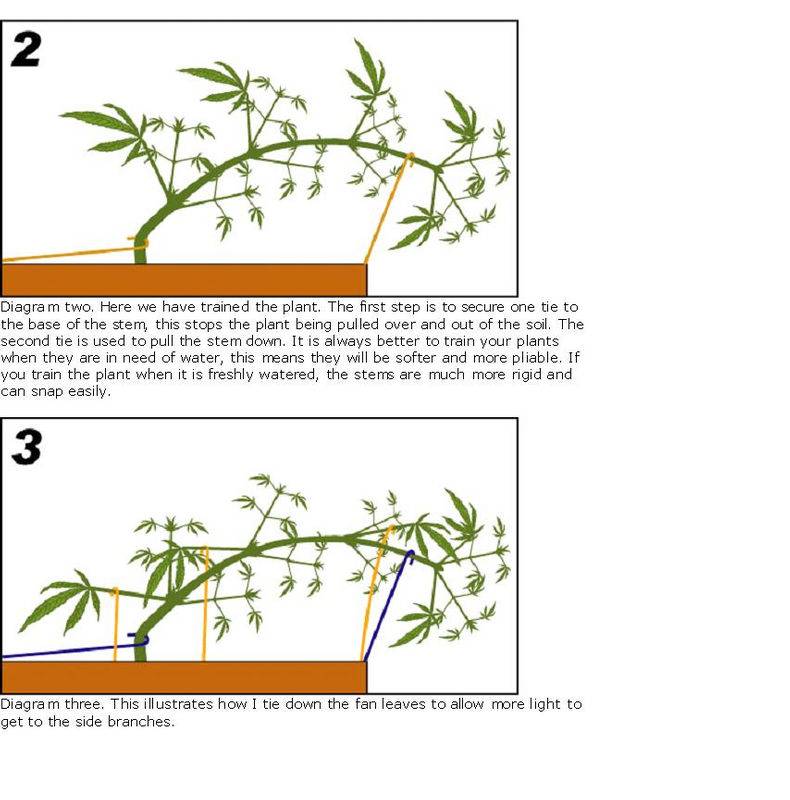
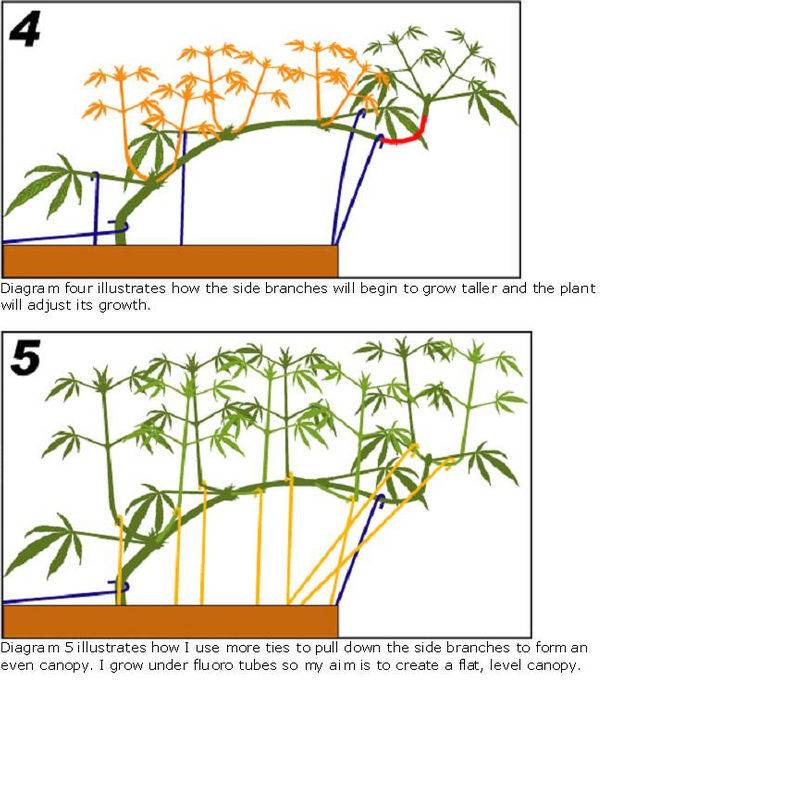
It is possible to keep tying down each new branch as it grows, which will result in a plant that grows into a dense bush. LST training combined with topping can be a very effective way of creating a plant that makes use of all the available space. The trick here is to top the plant at each new node and to keep the internodes as short as possible. Training the plant in this manner takes some time and there is no way to reach good results by being in a hurry. As you can see, the plant in this picture has been both topped and trained. If you look closely you can see where the branches have been tied to the pot.
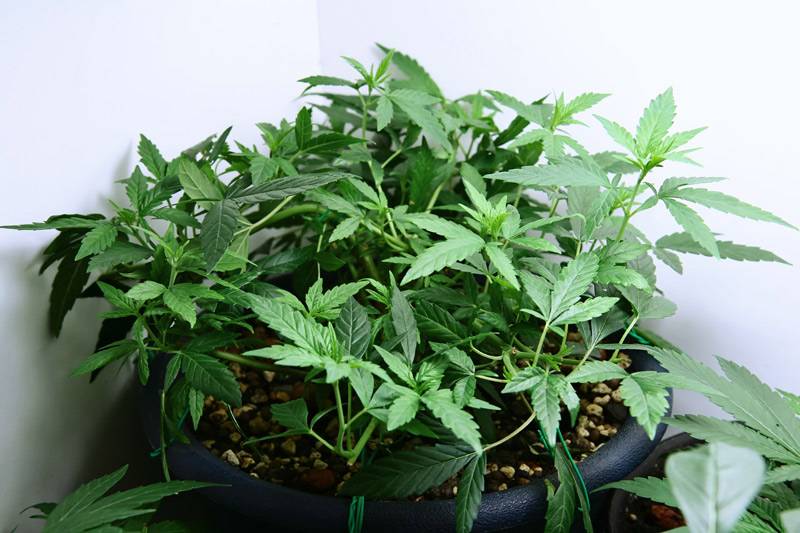
There are many ways to train a plant, each plant requires a slightly different treatment. The goal is however to get a plant that looks like the one in the picture above. Once that plant goes into flowering it will have many branches with many nodes, you can probably see what I mean. Once the bush gains size and starts to stretch, you will have to start pruning it carefully and wisely.
Just to demonstrate how differently plants can be trained, here are some pictures of plants in early training. All of them were topped first. By training a plant you can also slow down the stretch, especially in tropical sativas.
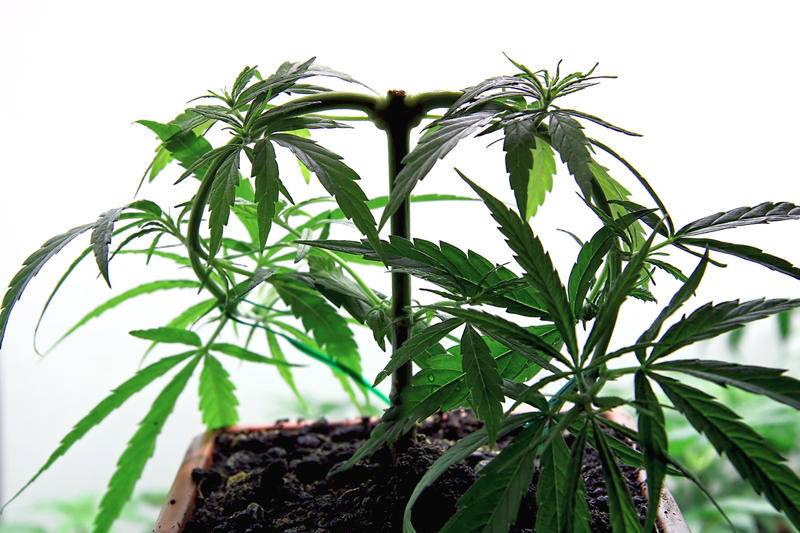
This Oldtimer’s Haze was stretching a lot and had quite long internodes so I topped it and trained it to grow around itself and eventually it grew into a sphere.
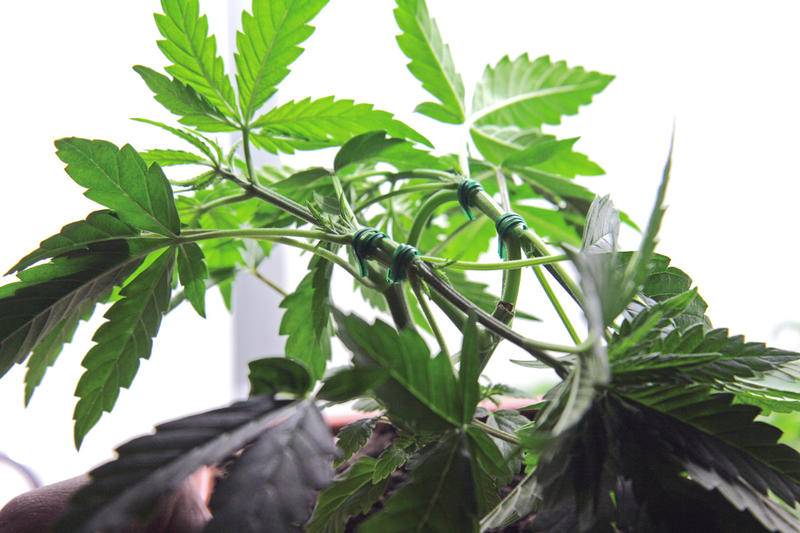
This Kali Mist plant did not like to be topped so I tried to slow it down by tying down the branches horizontally. In the end this plant preferred a few main colas so I stopped the training shortly after. Some plants will resist any attempts of training and respond poorly when you try. These plants will probably yield more when left untopped.
Here is an example of a Ingemar’s Punch plant that went through some serious LST training. This plant resembles a creeper vine more than a bush. Here the goal was to keep the plant as low as possible but usually the plant is allowed to grow in size and height so that it produces a larger crop. This example however illustrates the possibilities when it comes to training. Remember that even if your grow room is limited in height, you are not restricted to growing solely lowryders or other strains that stay low, as any plant can be trained to grow in any manner or form. This opens up possibilities for stealthy cab and pc grows. All you have to to is reserve some time for the training during veg and perhaps you will have to continue the training during flowering as well, like in the example above. Anything is possible.
Topping and training is also a good way to keep mother plants from growing too large. There are several good threads on how to keep bonsai moms on this forum so I will not venture further into that topic.
Scrogging
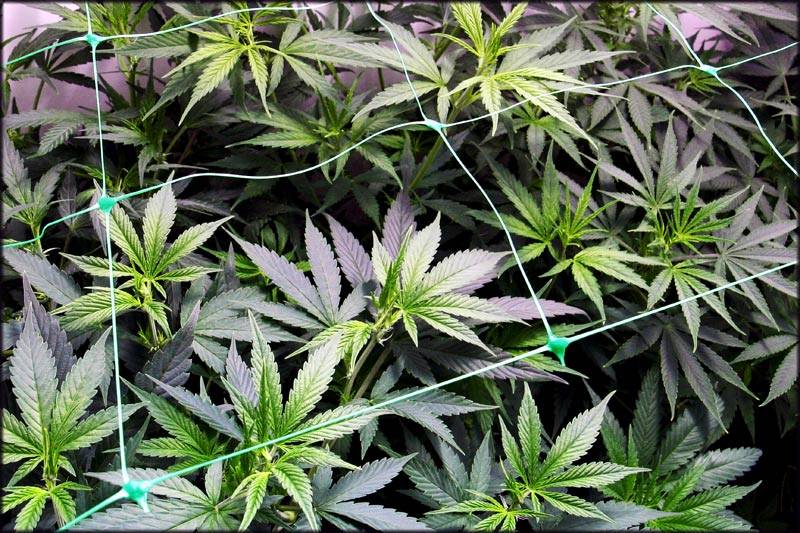
Scrogging, or Screen of Green means that you suspend a net over the plants and allow them to grow through it. This makes it easier to separate the growing branches so that they cover the entire area of the grow room. The scrog net also provides support as the buds can often become so heavy that that the branches cannot support them any more and break under the weight. Thereby the scrog net also removes the need for noisy fans, used to make the stems stronger through the waving effect. Personally never use fans due to limited space.
I usually train the plants for up to three months before flipping the switch, which means that they are thick stemmed and quite large in size. Although plants can be kept very low with training, my aim is to grow large and busy plants that produce the maximum amount of buds. Due to the long vegetative period, the plants are strong and healthy with an abundance of bud sites.
I try to keep the canopy even by topping the plants that stretch more but sometimes it is impossible, especially when growing both indicas and sativas at the same time. One has to adjust according to the plants and direct longer branches to the corners of the grow room, sometimes the only option is to tie the branches horizontally so that they are resting on the scrog net. This can be a strange sight as the flowers keep growing vertically out of the side of the bud.
The basic idea is that the training should be complete by the time the plants start flowering and grow through the net. Sometimes a second scrog net is necessary higher up if the plants need further support.
There are also different methods when it comes to scrogging, some people tilt the net so that one side is higher than the other, as this provides a greater surface area for the buds.
Sea of Green
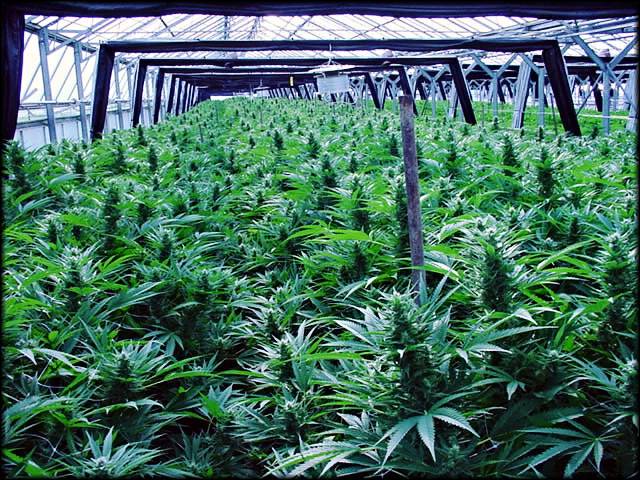
Sea of green or SOG is the method of growing where a multitude of smaller plants are grown instead of few larger ones. These smaller plants will mature faster and in less time than larger plants and one crop can be started while another is maturing. This saves the grower a lot of time and money as less time is required between crops. This method is also good for those wanting to make the most out of their smaller grow area.
Twice as many plants grown half as big will fill the grow space twice as fast, so harvests take place almost twice as often.
Although SOG is more of a style of growing than an actual technique that can be applied in order to increase the harvest, I still wanted to mention it here as this method of growing will under the right conditions actually increase the harvest. As opposed to growing a few larger plants in the same area that is. Since you want the buds to cover as much of the grow area as possible, one plant per sq. ft. is a good rule of thumb for SOG.
Plants should naturally not be topped when using the this method as the idea is to harvest the main cola from a whole bunch of smaller plants and topping them defeats that purpose. The SOG plants do not require any training either as that will only slow them down and delay the harvest. It is probably better to just grow more plants instead and fill out the entire surface area with as many plants as possible. In case the smaller plants do not fill up the entire area of the grow room, some minor LST training might be needed in order for them to branch out a bit more.
The SOG plants can also be Scrogged for further control over the plants. In order for this method to be truly effective, all the new plants would have to be clones from the same mother. That means that all the little plants will grow at the same rate, which is important for keeping an even canopy.
Although no topping and training is needed when growing SOG, the trimming of branches and fan leafs, especially lower ones, becomes a must because every little bit of space counts towards the harvest. By removing excess fan leafs that would otherwise block bud sites, the SOG grower improves on his yield. Since SOG grows usually contain a great number of plants in a relatively small area, the need for trimming fan leafs becomes apparent. After all, what we are after is a bountiful harvest and different methods apply to different styles of growing.
Pruning
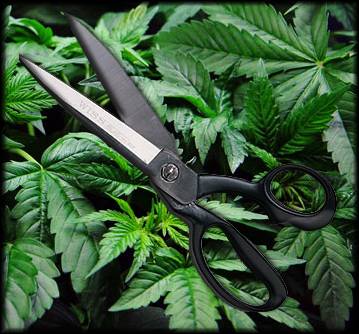
When the plant is left to grow as it chooses, it usually has more branches than it has the energy to support. This means that a lot of energy is wasted on smaller branches, especially the lower ones. The energy need is so spread out that in extreme cases flowering takes a very long time as the plant tries to supply energy evenly to every location. By removing some of the less important and weaker branches, you can ensure that the larger branches produce a greater amount of high quality bud. The bud on the lower branches that receive less light usually end up as single “pop corn” buds that never truly mature, so it is best to remove them at an early stage.
You become the “investment planner” for you plants. Observe the growth and remove any branch that has long internodes (the space between the nodes) and any branch that stays significantly lower than the main shoots. These branches will get very little light and they will also have a hard time to find they way up to the well lit area. Most of the time I end up removing almost all the growth underneath the scrog net, I only leave the fan leafs intact until the plant drops them by itself after the energy has been recovered.
When it comes to removing leaf material opinions vary, some remove leafs and others, like myself, chose not to. I have tried both methods and can honestly say that there is no positive effect really from removing leafs. Keep in mind that fan leafs are the primary location for photosynthesis and that the plant also stores surplus energy in them. By removing the leafs you do double harm, you handicap the plants ability to produce vital energy and you also remove the energy that has already been stored for future use. Furthermore, although it cannot be observed with the naked eye, light actually passes through the leafs and that is why some of the lower leafs stay green throughout the entire grow. It is better to tuck or tie the leafs under the canopy so that light reaches more bud sites, or alternatively cut the leafs in half.
Since most of the photosynthetic activity takes place in the fan leafs, the buds themselves do not need light, in other words, bud sites are activated by light when it hits the node but the energy is produced and transported to the buds from the leafs. This is where a scrog net also comes in handy, you can tie down the leafs without removing them and thereby allow more light to reach the buds while no energy is lost.
Sometimes you do not have a choice and must remove some of the growth in order to ensure that you get a good harvest. It all depends, some plants respond well to rigorous pruning but in general I would advice that you keep it to a minimum since there are optional methods to removing the leafs altogether. The rules of pruning are a bit different when it comes to growing SOG as you might have to remove some of the fan leafs because the plants are packed so close together.
I think that the best advice is to watch your plants closely and adapt your technique and grow style according to the needs of the plant. Nothing is set in stone when it comes to growing.
All grow rooms are different and so is each strain of cannabis. In fact every plant is different from the next so you will have to try out what works best for you. I hope that this guide at least gave you a picture of what the methods are and how they can be used for an increased harvest.
Happy growing
T
theratings
This is the topic that anyone with any questions about plant training should see. Good job man.
This is truly an incredible tutorial, thanks
I have a theory I hope to try out someday that takes into account both "the auxin transport system" and light-bending. LST takes advantage of light-bending in a stationary way.
I'm working on a way to grow Omnidirectional.
I have a theory I hope to try out someday that takes into account both "the auxin transport system" and light-bending. LST takes advantage of light-bending in a stationary way.
I'm working on a way to grow Omnidirectional.


